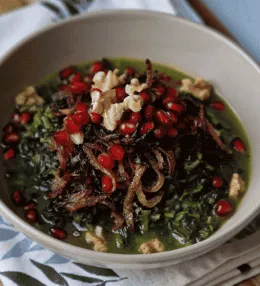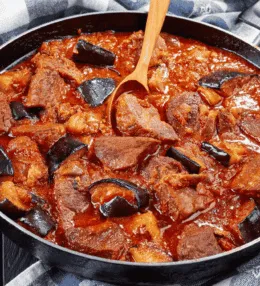
- View
Table of Contents
TogglePork Pie is a traditional British creation, firm pastry encases seasoned pork, baked slowly until tender, with a layer of savoury jelly sealing the meat. It is both robust and neatly contained, making it easy to serve cold.
Often found in picnics, pubs, and market stalls, the pie is as much about setting as taste. Its hearty texture and balanced seasoning mean it can stand alone, though it is often enjoyed with pickles, mustard, or a sharp chutney.
Despite its humble appearance, it has a complexity that surprises. The contrast between crisp pastry, dense filling, and smooth jelly gives it a structure that feels purposeful, designed to be practical yet satisfying.
Want to dive deeper into British Cuisine? Don’t miss our post on Traditional British Foods to Try
What Is Pork Pie?
A traditional Pork Pie is made by encasing coarsely chopped or minced pork inside a hot water crust pastry. Once baked, stock is poured into the gap between the pastry and meat, setting into jelly that preserves the filling and locks in moisture.
The pie is baked in a mould, which helps it keep its cylindrical or oval shape. When sliced, it reveals layers: golden crust, a firm layer of pork, and translucent jelly. Each part plays its role, and the result is both striking and functional.
Served cold, it works well as part of a picnic spread or as a standalone meal. Its sturdy design and lasting flavour make it a favourite for occasions where food needs to travel and remain enjoyable hours after baking.
Ingredients and Taste
The pastry is made using hot water, lard, and flour, producing a dough that is firm but pliable. It holds its shape while providing a buttery crunch that contrasts neatly with the softer filling inside.
The filling is usually pork shoulder, sometimes mixed with belly or cheek for extra fat and flavour. It is seasoned with salt, pepper, and often nutmeg or mace, creating a spiced warmth that blends with the natural sweetness of the meat.
The jelly is traditionally a rich pork stock, simmered with bones and cooled to set within the pie. It adds moisture and depth, ensuring the meat does not dry out while giving each slice a distinctive texture and savoury edge.
A Taste of History
Pork Pies trace their roots to medieval England, when meat was baked inside thick crusts to preserve it. The crust, known then as a coffin, was not always eaten, but over time the pastry became an edible and valued part of the dish.
By the 18th century, recipes began to resemble what is recognised today, with hot water crusts allowing for strong walls that held their form. The addition of jelly came later, providing both preservation and flavour.
Melton Mowbray in Leicestershire became especially associated with the pie, where skilled bakers refined the recipe and protected its reputation. The Melton Mowbray Pork Pie is now geographically protected, recognised for its hand raised pastry and distinctive flavour.
The pie became popular among travellers, labourers, and picnickers alike. It kept well, could be carried without fuss, and delivered a hearty meal in compact form. Its enduring appeal lies in that blend of practicality and flavourful tradition.
Today, Pork Pie remains a staple of British culinary identity. It appears on festive tables, in pub counters, and in picnic baskets, often alongside a pint of ale or a sharp pickle. It is a dish that continues to hold meaning through both taste and history.
How to Make Pork Pie (Meat Pie in Jelly)
The classic British pork pie is a savoury pastry filled with seasoned pork and sealed with a rich jelly, offering both flavour and structure. Known for its firm hot water crust and hearty filling, it is best enjoyed cold, sliced thick, and served with mustard or pickles. See the recipe card at the bottom for printable directions
Ingredients
For the filling
- 500g pork shoulder, finely diced
- 200g pork belly, finely diced
- 100g streaky bacon, finely chopped
- 1 tsp salt
- ½ tsp black pepper
- ½ tsp ground nutmeg
- ½ tsp dried sage
- ½ tsp mace
For the hot water crust pastry
- 450g plain flour
- 100g lard
- 100g unsalted butter
- 200ml water
- 1 tsp salt
For the jelly
- 2 pig’s trotters (for stock) or 3 gelatine leaves
- 1 onion, halved
- 1 carrot, roughly chopped
- 2 bay leaves
- 6 black peppercorns
- 1 litre water
For finishing
- 1 egg, beaten (for glaze)
Cooking Instructions
Step 1: Prepare the jelly stock
To begin, place pig’s trotters, onion, carrot, bay leaves, and peppercorns in a large pot. Cover with water and simmer gently for 3–4 hours until reduced. Strain and set aside. If using gelatine, bloom in warm water later and add to hot strained stock. Move on to making the pastry.
Step 2: Make the hot water crust pastry
In a saucepan, heat water, lard, butter, and salt until melted. Immediately pour over the flour in a large bowl and stir with a wooden spoon. Knead briefly until smooth. Keep warm and pliable by covering with a cloth. Prepare the pie tin next.
Step 3: Line the pie tin
Take two thirds of the pastry and roll it out thickly. Line a greased 20cm springform tin or traditional pie mould. Press firmly into the corners but avoid cracks. Leave pastry slightly overhanging at the top. Transition to preparing the filling.
Step 4: Season the pork filling
In a bowl, combine pork shoulder, pork belly, and bacon with salt, pepper, nutmeg, sage, and mace. Mix thoroughly by hand for even seasoning. This ensures depth of flavour in every slice. Transition to assembling the pie.
Step 5: Fill the pie
Spoon the pork mixture into the pastry case, pressing down firmly to avoid air pockets. Dome the filling slightly higher in the centre. Move to sealing with pastry lid.
Step 6: Seal with pastry lid
Roll out the remaining pastry to form a lid. Place over the filling, press edges firmly together, and crimp neatly. Cut a small hole in the centre to allow steam release. Proceed to glazing.
Step 7: Glaze and bake
Brush the pastry with beaten egg. Bake in a preheated oven at 180°C (fan 160°C) for 30 minutes, then reduce to 160°C (fan 140°C) and bake for another 1 hour 15 minutes. Allow to cool slightly before adding jelly.
Step 8: Add the jelly
Warm the prepared stock (or gelatine mixture). Pour carefully into the steam hole using a funnel, letting it settle into gaps between meat and pastry. Chill in the fridge for at least 4 hours or overnight until jelly sets.
Final Step: Serve the pie
Slice thickly and serve cold with English mustard, pickles, or a simple salad. Presentation tip: Pair with chutney for balance or place on a wooden board for a rustic serving style.
Variations and substitutions
- Replace pig’s trotters with chicken stock and gelatine for a simpler jelly.
- Swap streaky bacon with smoked pancetta for deeper flavour.
- If mace is unavailable, increase nutmeg slightly.
- Use a loaf tin if a springform tin is not on hand.
Cooking Tips for Perfect Pork Pie
- Dice the pork by hand instead of mincing to retain authentic chunky texture.
- Keep the pastry warm but not sticky when lining the tin.
- Add jelly slowly in stages to fill gaps and prevent leaks.
- Allow pie to cool completely before slicing for neat portions.

British Pork Pie (Meat Pie in Jelly)
Ingredients
For the filling
- 500 g pork shoulder finely diced
- 200 g pork belly finely diced
- 100 g streaky bacon finely chopped
- 1 tsp salt
- ½ tsp black pepper
- ½ tsp ground nutmeg
- ½ tsp dried sage
- ½ tsp mace
For the hot water crust pastry
- 450 g plain flour
- 100 g lard
- 100 g unsalted butter
- 200 ml water
- 1 tsp salt
For the jelly
- 2 pig’s trotters for stock or 3 gelatine leaves
- 1 onion halved
- 1 carrot roughly chopped
- 2 bay leaves
- 6 black peppercorns
- 1 litre water
For finishing
- 1 egg beaten (for glaze)
Instructions
- To begin, place pig’s trotters, onion, carrot, bay leaves, and peppercorns in a large pot. Cover with water and simmer gently for 3–4 hours until reduced. Strain and set aside. If using gelatine, bloom in warm water later and add to hot strained stock. Move on to making the pastry.
- In a saucepan, heat water, lard, butter, and salt until melted. Immediately pour over the flour in a large bowl and stir with a wooden spoon. Knead briefly until smooth. Keep warm and pliable by covering with a cloth. Prepare the pie tin next.
- Take two thirds of the pastry and roll it out thickly. Line a greased 20cm springform tin or traditional pie mould. Press firmly into the corners but avoid cracks. Leave pastry slightly overhanging at the top. Transition to preparing the filling.
- In a bowl, combine pork shoulder, pork belly, and bacon with salt, pepper, nutmeg, sage, and mace. Mix thoroughly by hand for even seasoning. This ensures depth of flavour in every slice. Transition to assembling the pie.
- Spoon the pork mixture into the pastry case, pressing down firmly to avoid air pockets. Dome the filling slightly higher in the centre. Move to sealing with pastry lid.
- Roll out the remaining pastry to form a lid. Place over the filling, press edges firmly together, and crimp neatly. Cut a small hole in the centre to allow steam release. Proceed to glazing.
- Brush the pastry with beaten egg. Bake in a preheated oven at 180°C (fan 160°C) for 30 minutes, then reduce to 160°C (fan 140°C) and bake for another 1 hour 15 minutes. Allow to cool slightly before adding jelly.
- Warm the prepared stock (or gelatine mixture). Pour carefully into the steam hole using a funnel, letting it settle into gaps between meat and pastry. Chill in the fridge for at least 4 hours or overnight until jelly sets.
- Slice thickly and serve cold with English mustard, pickles, or a simple salad. Presentation tip: Pair with chutney for balance or place on a wooden board for a rustic serving style.
Nutrition
You May Also Like







Leave a Review